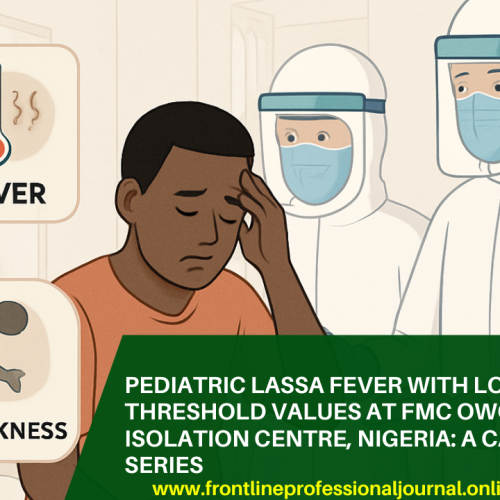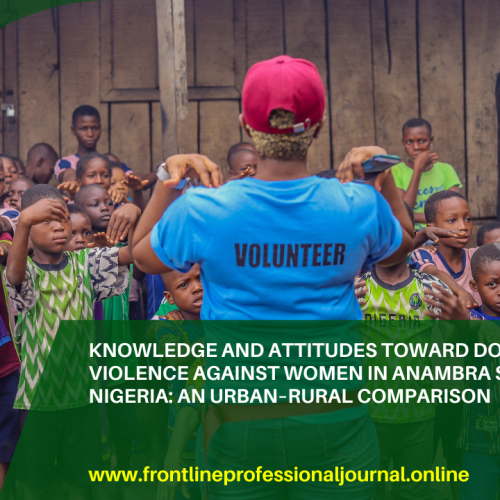Irene Uju Okeke, Chidozie Reginald Aniemena, Uzoma Chidi Okereke, Perpetua Onyinye Nnemelu, Martins Nwabueze Okolie, Debra Ukamaka Okeh
Citation: Okeke I U, Aniemena C R, Okereke U C, Nnemelu P O, Okolie M N, Okeh D U (2025) Socio-economic determinants of malnutrition among urban-rural school age children of Enugu state, Nigeria. Frontline Professionals Journal, 2(1), 34–53.
ABSTRACT
Background: School feeding programs have been implemented in Nigeria to improve education outcomes and reduce hunger among school children. However, sustaining these programs remains
a challenge. In Southeast Nigeria, urban-rural disparities in socioeconomic status, food security, and access to education exist, affecting caregivers’ ability and willingness to pay for school feeding programs. Malnutrition remains a pervasive and intractable public health challenge in Nigeria, particularly among school-age children. The phenomenon of malnutrition is complex and multifaceted, influenced by a myriad of socio-economic factors that vary across different geographic locations, including urban and rural areas. Enugu State, located in the southeastern region of Nigeria, is not exempt from the challenges of malnutrition. The state’s urban and rural areas exhibit distinct socio-economic characteristics that
influence the nutritional status of school-age children. Understanding the socio-economic determinants of malnutrition among urban and rural school-age children is crucial for developing effective interventions aimed at mitigating the scourge of malnutrition.
Methodology: This study was a comparative, cross-sectional descriptive study carried out in the selected communities in Enugu State, South East Nigeria., involving households four (two urban and two rural) communities. The sample size was 422 where participant were selected using multistage sampling technique The questionnaire was adapted from National Health Demographic Health Survey, pre-tested semi-structured interviewer administered in English language. Data were collated, assembled and analysed using International Business Machine (IBM), Statistical Package for Social Science (SPSS) version 23. Descriptive statistics as percentages and frequency were presented in tables. The mean and standard deviation of parameters in each community were obtained and statistical tests of association between the dependent and independent variables were also carried out and the level of statistical significance was set at P ≤ 0.05. The research protocol was reviewed and approval for the project was sought from the Ethics Review Committee of Nnamdi Azikiwe University Teaching Hospital. Consents were gotten from traditional rulers/village heads before the commencement of the study. All subjects had the right to withdraw from the study anytime they wish without explanation. Confidentiality was maintained throughout the study.
Results: Most of the respondents were female 262 (62.4%) and 158 (37.6%) were males with majority of the respondents having formal education 401 (95.48%) and 194(46.19%) completed tertiary education. Majority of the respondents were household representatives 254(60.5%). On Marital status of respondents 371(88.3) were married, followed by 34(8.1%) respondents that were single parents. 159 of the 420(37.9%) respondents were government employee, 113(37%) respondents were self-employed and 70(16.7%) of the respondents were unemployed. most of the care givers in urban areas feed their children at school daily 151(72.25%) before health education and 146(69.86%) after health education. On why the care givers will like to enrol their child with school feeding program 156(74.64%) respondents indicated that it is based on the free provision of food for their children before health education and 143(68.42%) still indicated that after health education. On the likely reason that will make the care givers enrol their children for school feeding program, 164(78.47%) respondents were of the opinion that children look very tired after school. Most of the care givers in rural areas feed their children at school daily 52(24.64%) before health education and 4(1.90%) after health education. On the likely reason that will make the caregivers enrol their children for school feeding program 66(31.28%) respondents opined that children look very tired after school Most respondents believed that the people needed to be involved in school feeding should be the school authority 163(77.99%) before health education and parents 124 (59.33%) after health education. On likely place where the food should be prepared, 53(25.36%) of the respondents before and after health education felt it should be done within the school premises. On how the food item should be sourced, 101(48.33%) of the respondents before and after health education felt it should be from locally available foods and other sources. After health education 28 (13.27%) respondents felt it should be within school premises Most poor (Q1), Very poor (Q2), Poorer (Q3), Poor (Q4) and Least poor (Q5) were the socio-economic grading.
Conclusion: This study assessed the socio-economic determinants of malnutrition among urban and rural school-age children in Enugu State, Nigeria. The findings revealed that poverty, low maternal education, inadequate access to health care, and poor sanitation and hygiene practices are significant factors affecting school feeding and leading to adverse consequences of malnutrition among school-age children in both urban and rural areas. The study also highlighted the existence of urban-rural disparities in the prevalence of malnutrition, with rural areas exhibiting higher rates. It is hoped that to develop and Implement Nutrition-Sensitive Policies: The government should develop and implement policies that address the nutritional needs of school-age children, particularly in rural areas. Nutrition Education: Provide nutrition education to caregivers and school-age children to promote healthy eating habits and reduce the risk of malnutrition.
Keywords: Socio-economic factors, school feeding, school age children, Caregivers.







